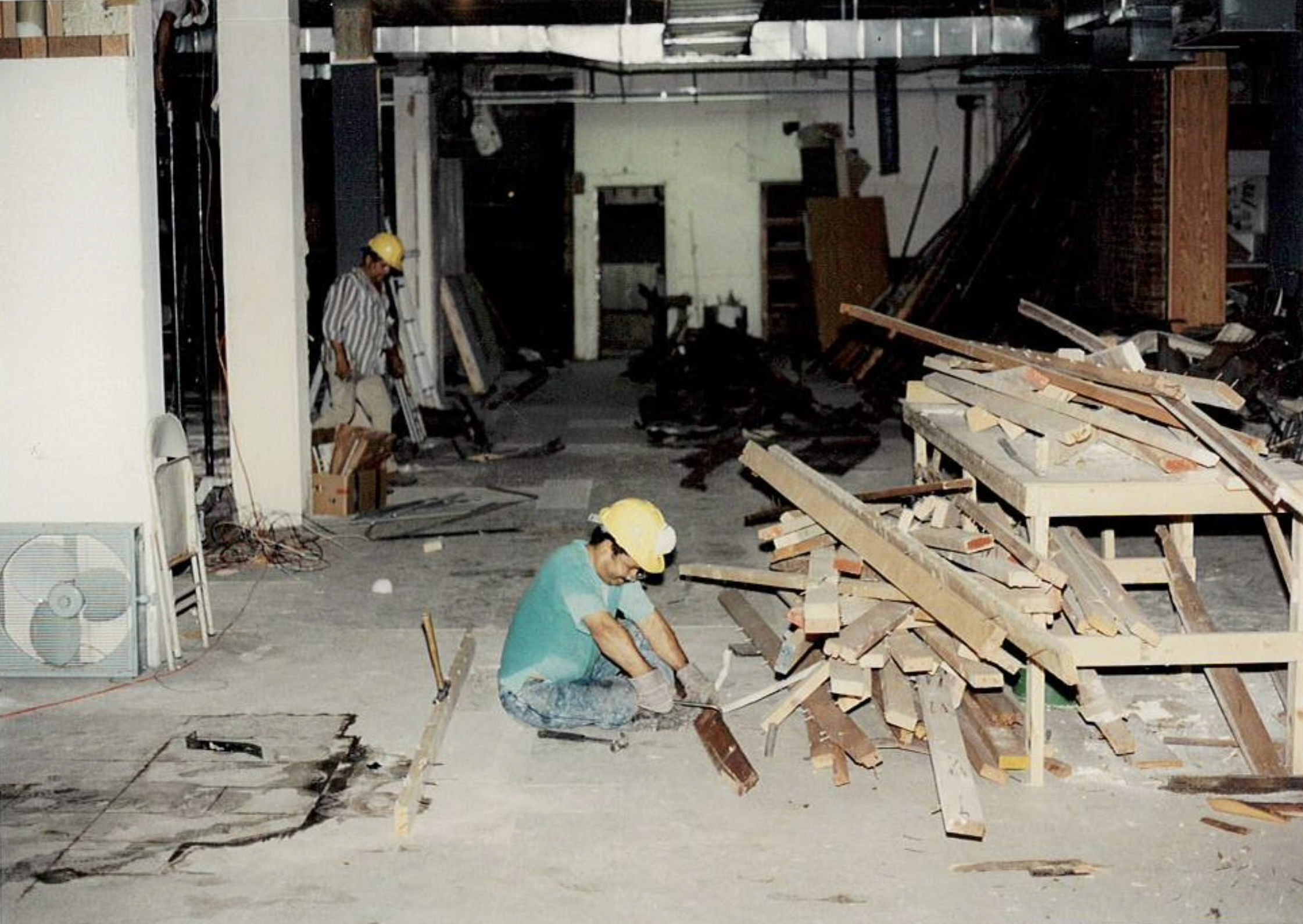
EXPLORING CHURCH SPACES: CHALLENGES
Challenges and Solutions for Maximizing Church Spaces in Boston
by Saranya Sathananthan, Researcher in Residence
One of the main observations from this study is that most of the churches that participated were well-aligned when it came to utilizing their property for mission. It should come as no surprise, given that numerous churches in the city rent to other congregations, provide office space for nonprofits, or allow community members to host events for nominal fees.
While this represents a great strength in how churches utilize their properties in Boston, it still represents only a fraction of what could be happening. (See this list of innovative uses of church spaces.) Despite this potential, several barriers prevent churches from fully utilizing their properties for mission.
Vision and Mission
A key indicator in determining how open a congregation is to creatively using its property lies in the theology of its senior leaders regarding sacred space and stewardship. The research revealed that leaders with a broader understanding of stewardship often cast a vision for their congregation that embraced opening their buildings to the rest of the community for purposes beyond worship services. Some leaders saw the church building as a tool for ministry, expressing a desire for it to bless the surrounding community. Others shared their perspectives on the sacredness of a building itself. While some expressed that the architecture or history of their building drew people to the church, leaders who viewed the physical structure as "just a building"—with the sacredness residing in the people and activities where God's presence is invited—tended to foster a more flexible, community-focused use of their spaces.
However, some leaders experienced notable tension when they tried to shift their congregation's mindset about property use. Some expressed that their church's subculture leaned toward risk aversion, with worst-case scenarios prompting people to want to close their doors and retreat into enclaves rather than serving as launching pads for their communities. In other contexts, leaders noted that specific subgroups, having worked hard to secure their space, were highly protective of their resources. They feared that opening their doors could lead to misuse or loss, which made them hesitant to fully embrace the potential of their church property to serve a wider group of people.
Aging Infrastructure Against Limited Funds
One of the most pressing issues facing many Boston churches is the undeniable reality of aging infrastructure. Over 50 churches in the city are registered as historic landmarks, and many church buildings, regardless of these official designations, are old and need significant repairs. Unfortunately, the funds required to address these issues are often limited, particularly for smaller, dwindling congregations that struggle even with the regular upkeep of their expansive historic buildings.
This issue is not unique to Boston; it mirrors trends in other major cities and Western nations. In the United Kingdom, over 2,000 church buildings have closed during the past decade.1 In New York City, more than three dozen houses of worship and similar buildings were razed or redeveloped in Manhattan alone between 2013 and 2018,2 often replaced by high-end condos. Each year, congregation closures outnumber new church starts in the U.S. by 50%, according to Lifeway Research. In 2019, prior to the pandemic, although about 3,000 new Protestant churches were planted, 4,500 Protestant congregations closed. In Boston, over recent decades, about 45 buildings owned by churches have been lost to the Christian community, primarily through sales to developers and private commercial entities.
Another aspect of this challenge is that many church buildings in Boston are not fully accessible, up to code, tech-equipped, or readily transformed for different needs. Moreover, historic designations restrict how churches can renovate many of these buildings. These limitations hinder churches' ability to serve their communities effectively, particularly in welcoming people with disabilities or hosting events that require modern amenities. A combination of even a few of these conditions can significantly limit how the space can be used, preventing churches from fully utilizing their buildings for diverse activities or adapting them to meet modern needs. Notably, many churches participating in this project had fires that rendered certain spaces of their churches unusable for years before repairs could be made.
Do churches spend their limited resources on maintaining or updating their buildings, or should they abandon ownership and focus their funds directly on ministry activities?
The cost of bringing these buildings up to current standards can be prohibitive, particularly for congregations already struggling financially. The cumulative effect of deferred maintenance leading to more significant issues has resulted in many churches closing, with buildings left abandoned,3 sold, or even demolished.
This situation presents a dilemma for many pastors: Do churches spend their limited resources on maintaining or updating their buildings, or should they abandon ownership and focus their funds directly on ministry activities?
"We sold our former building for a very good price, but now the question is, shall we use it on brick and mortar?” Pastor Daniel Chan of Boston Chinese Evangelical Church in Boston’s Chinatown said. “Our deacons are raising the question of whether we should spend the money on ourselves (on a new multifunctional sanctuary) or spend the money directly on the community. So we are still struggling and debating."4
Limited Leadership Capacity and Training
Limited leadership capacity in many congregations further complicates their decision-making regarding church infrastructure. Pastors and church leaders are often stretched thin, balancing their congregations’ spiritual needs with the practical demands of maintaining their facilities. Many seminaries do not provide pastors with practical education on facilities maintenance or the business acumen needed to run a church, leaving leaders to learn on the job.
“The main challenge is inexperience, just not knowing what we're doing for a lot of these things,” Pastor Larry Kim of Central Square Church in Cambridge, Massachusetts, said. “There's always a new surprise here in this building, and it's trying to figure out how to problem-solve those things. It’s like I'm learning things for the first time.”5Although some denominations have long provided practical support for church operations, facilities management, and loans for repairs and upgrades, we are now finally seeing a broader range of resources and services that better equip leaders with the knowledge they need becoming available.
“There's no lesson like on-the-job training,” Pastor Kurt Lange at East Coast International Church in downtown Lynn, Massachusetts, said. “But there are now books written by Christian authors and church leaders in this space that I do think a lot of pastors need to read.”6Pastor Kurt Lange's Recommended Reading List
Delegating facilities management and related responsibilities to non-pastoral roles can benefit churches with the capacity to hire staff or manage volunteers. However, this may not be feasible for smaller churches with limited internal resources. Whether the church hires staff or enlists volunteers to assist with facilities management, make repairs, write grants, or take on other specialized roles, investing in the professional development of these staff members and volunteers is essential. If church leaders don’t learn what is needed, others cannot be expected to know this information, even if they bring relevant skill sets to their roles. Each church situation is unique, and the number of intersecting decisions to be made at any given time makes it challenging even for the most trained or experienced professionals. Churches that understand the value of investing in their leaders are more likely to succeed, and recognizing those who manage and maintain the facilities as essential to the church will contribute to its overall success.
“If we want to help our staff members to be successful, we need to provide training for them,” Pastor Chan of Boston Chinese Evangelical said. “Our facility manager needs training on property management, our technician needs training to develop skills to make repairs, and we realized that we may need to put more money into training even our pastor, who is coordinating all this. He didn't study this in seminary. So we realized we need a budget for training our people.”Even if a church lacks the funds to hire staff, outsource services, or send people for professional training, sharing knowledge within the congregation can be a valuable way for everyone to contribute to the overall vision. Tapping into the expertise of individuals who can teach or offer specific skills and “doing it together” can foster shared experiences that build missional solidarity.
Find out who your people are and what they know. Include everybody in your parish, because there's all kinds of good ideas out there.
— Jim Woodworth, Cathedral Church of St. Paul
“Find out who your people are and what they know. Include everybody in your parish, because there's all kinds of good ideas out there,” Jim Woodworth, facilities manager at the Cathedral Church of St. Paul in downtown Boston, said. “But sometimes you’ve got to draw them out of people.”7
“Some of my people aren't in the workforce,” Pastor Lange of East Coast International said. “So we’re teaching people how to paint, hold a drill, etc., for people who have never had a chance to do it.”
He shared that the sending church they came out of would have hired a company to make any necessary repairs or do construction, but that they were not at a place where they could afford it when they were a church plant. Though their circumstances have changed since then, he still emphasized the need to think through whether to hire an outside company.“Sometimes just because it may be easier for us to pull it off, or faster, or better, we have learned that there are some real interesting discipleship opportunities in working with people, like doing manual labor together.” Pastor Lange said. “So we kind of enjoy it—working with people in that capacity.”
An observation from the research revealed that when an entire congregation is committed to the vision for the church building, there’s more significant motivation for everyone to contribute. It is the task of church leadership to communicate that vision effectively, from the leadership level to every person in the congregation and beyond or cultivate that vision together through a series of discussions that brings together various stakeholders. This process is vital, whether the church has abundant or minimal resources for the upkeep of facilities.Take Congregación León de Judá in the South End neighborhood of Boston, for example. Under the direction and vision of Pastor Roberto Miranda, the congregation purchased a building in the South End in 1994 and undertook a decade-long renovation, with members volunteering their time and skills and resourcing supplies to build the church.
Javier Encina, the facilities manager at León de Judá, described church teams tearing flooring from homes and putting it back together in that building, almost completely fitted with donated materials.“It took us around 10 years, between volunteers and salvaging materials and reusing them, to build this church,” Mr. Encina said. “We built this building with the sweat of the people. All the work and manual labor on the church was done by the people of this church.”
No wonder this hallmark congregation takes deep pride in their building and invests in its upkeep, ensuring it remains a welcoming place for their members and the broader Boston community.






Figs. 1-4 Members of Congregación León de Judá work together on reconstructing the Harrison building, the first building they purchased in the South End. Figs. 5-6 Hallway and entrance to the Harrison building. Photos courtesy of Congregación León de Judá.
The Difficulties of Decision-Making and Management
Effective decision-making regarding the use and maintenance of church properties is often complex and challenging. Many churches have governance structures that can slow decision-making, leading to frustration and burnout among those responsible for managing the property. Establishing a dedicated team to handle property management can alleviate the burden on pastoral staff, but this requires careful planning and clear communication.
Deciding to expand the use of church space introduces new challenges. Questions arise, such as who will open the space, manage access, troubleshoot issues, ensure security, handle cleanup, and deal with inevitable wear and tear. Churches may need to consider growing their team and delegating additional leadership responsibilities.Moreover, churches often face bureaucratic obstacles from the city or state when adapting their spaces for new uses, particularly regarding regulations for activities involving minors or other vulnerable populations and the need to obtain special permits. When a church transitions to additional usages, even adding a single one could elicit numerous issues. These challenges can be daunting and may discourage churches from moving forward if not carefully considered. Every church I interviewed expressed these challenges when opening their space for additional use beyond Sunday services.
Helpful Mindsets and Postures
When asked how they navigate these challenges, several leaders shared helpful mindsets they adopt.
"I expect things to go wrong. I expect to have to switch gears constantly. We prioritize, and then we re-prioritize. But that's the job."
— Jim Woodworth, facilities manager at the Cathedral Church of St. Paul in downtown Boston, on the need for flexibility
“Be nimble and pivot.”
— Laura Mitchell, Director of Children and Youth, from Central Square Church in Cambridge, MA, reflecting on the challenges with their building’s heating. They had to rearrange everything and move from the sanctuary to the fellowship hall for a few months.8
“Lead with patience. We have to be mediators, understanding everyone’s point of view."
— Yulieth Ramos, the administrative assistant at Congregación León de Judá in the South End neighborhood of Boston, describing how she manages the frustrations of staff or members when a group leaves a mess after an event9
“You’ve got to be willing to be innovative and entrepreneurial. What has helped our church is avoiding the mindset of 'we've always done it this way' or 'we've never done it that way.' … Maybe God is trying to move flexibly with us, but we're staying rigid, not allowing God to do what He’s trying to do. That flexibility is tied to good stewardship—managing things properly, responsibly, ethically, and justly."
— Pastor Darrell R. Hamilton II of First Baptist Church of Jamaica Plain in Boston, on the value of innovation and the need for flexibility10
For churches who share their space with other groups, it’s also crucial to be aware of cultural differences and power imbalances between host and guest and how they can impact relationships. EGC conducted research on congregations sharing space in 2012 and section three and four of this blog post on Shared Worship Space11 has additional factors to consider when sharing space where there are major cultural and economic differences between the hosting congregation and groups that share their space.
People, Processes, and Communication
Many pastors emphasized the importance of the right processes and people in overcoming challenges.
"I don’t know what I’m doing half the time," Pastor Christina Tinglof of Forest Hills Covenant Church in Boston, admitted. "I would say to other pastors: make sure you’re not making decisions on your own. It’s important to involve others."12Pastor Hamilton echoed this sentiment, stressing that "cultivating a good team is critical."
Cultivating a good team is critical.
— Pastor Darrell R. Hamilton II, First Baptist Church of Jamaica Plain
When things don’t go as planned, Pastor Lange of East Coast International shared their approach to handling issues with outside groups that use their space: “We make sure to maintain a benevolent attitude towards other churches that use our facilities, but that requires us to have quick conversations whenever something goes wrong.”
Establishing clear internal processes and communicating space usage guidelines to everyone involved takes time, often requires trial and error, and can be frustrating—just like any growing pains. Each church's processes and policies may need to adapt during different seasons of change and transition.
The most significant takeaway from leaders' experiences in successful property management is the importance of pacing. Churches don’t need to do everything at once. It’s often better to start with small, manageable changes, learning from those experiences before expanding further. This iterative, flexible approach allows churches to refine their processes and avoid being overwhelmed by the demands of managing an active, multifunctional space. Trying something new might sometimes feel like taking one step forward and five steps back, but having the resilience to address setbacks before moving forward is critical to long-term growth and sustainability.
It cannot be one size fits all.... We have to work with the moment.
— Pastor Marc Lefevre, Boston Missionary Baptist Church
One fascinating observation from my conversations with church leaders was the contradictory nature of the advice they offered. One person would recommend having a single administrative person manage all scheduling online, while another said they’re OK with multiple pastors managing the schedule without an online calendar. A few advocated strongly for outsourcing repair work, while another made the case for involving volunteers from the church. Some pastors advise being deeply involved in management details, while others recommend delegating those tasks. These different approaches taught me early on that there’s no single solution. Each church should take inventory of its strategies, weigh the pros and cons, and decide what works best, then reassess and adapt as circumstances change.
“It cannot be one size fits all,” Pastor Marc Lefevre of Boston Missionary Baptist Church in Roxbury, Massachusetts, said. “Based on who we are, we can do it this way. Yet when we become bigger, it would be impossible to do it the same way. When we were only 15, or when we were only 100, that was a different ballgame. But now that we are a growing church, you have to do things differently. We have to work with the moment.”13
- Rachel Pfeiffer, “After 2,000 UK Church Buildings Close, New Church Plants Get Creative,” Christianity Today, May 25, 2022, https://www.christianitytoday.com/2022/05/uk-england-church-close-anglican-buildings-restore-new/.↩︎
- C. J. Hughes, “For Churches, A Temptation to Sell,” New York Times, October 4, 2019, https://www.nytimes.com/2019/10/04/realestate/for-churches-a-temptation-to-sell.html.↩︎
- Matthew Christopher, “Why Are There So Many Abandoned Churches: Changing Neighborhoods, Loss of Faith, Even Heating Bills Make Places of Worship Among the Most Common Types of Forgotten Places,” Atlas Obscura, February 29, 2024, https://www.atlasobscura.com/articles/abandoned-churches.↩︎
- Daniel Chan, interview by author, September 20, 2023.↩︎
- Larry Kim, interview by author, October 11, 2023.↩︎
- Kurt Lange, interview by author, November 3, 2023.↩︎
- Jim Woodworth, interview by author, September 29, 2023.↩︎
- Laura Mitchell, interviewed by author, October 11, 2023.↩︎
- Yulieth Ramos, interviewed by author, August 30, 2023.↩︎
- Darrell R. Hamilton II, interviewed by author, February 22, 2024.↩︎
- Bianca Duemling, “Shared Worship Space - An Urban Challenge and a Kingdom Opportunity,” Emmanuel Research Review reprint Issue No. 74, January 2012, https://www.egc.org/blog-2/2012/1/16/shared-worship-space-an-urban-challenge-and-a-kingdom-opportunity.↩︎
- Christina Tinglof, interviewed by author, November 2, 2023.↩︎
- Marc Lefevre, interviewed by author, November 10, 2023.↩︎
